What Is a Contact Center and How Does It Work

A contact center helps businesses manage customer interactions through channels like phone, chat, email, and social media. Companies use contact centers to answer questions, solve problems, and support customers every day. Contact center operations track key metrics such as Net Promoter Score and Customer Satisfaction Score. These metrics show how well agents resolve issues and help improve service. Sobot AI powers contact centers with advanced tools, making customer service faster and more reliable. Sobot combines all channels in one platform, so customers get quick and easy support.
Contact Center Basics
What Is a Contact Center
A contact center acts as a central hub where businesses manage customer interactions across many channels. The industry defines a contact center as a modern evolution of the call center. It operates on the cloud and connects with customers through email, chat, SMS, calls, and social media. This unified platform helps companies deliver seamless customer service and support. Unlike a traditional call center, which focuses mainly on phone calls, a contact center handles all types of communication. Businesses use contact centers to answer questions, solve problems, and build strong relationships with customers. This approach improves customer satisfaction and loyalty by making it easy for people to reach out in the way they prefer.
Contact centers help companies provide fast, accurate, and friendly customer service, no matter which channel the customer chooses.
The most common channels managed by contact centers include voice calls, email, live chat, and non-digital voice. The table below shows how customers and businesses use these channels:
| Channel | Usage / Preference Statistic | Source |
|---|---|---|
| Voice Calls | 41% of businesses prefer voice calls for issue resolution | Hiya (2022) |
| 57% of customers prefer email interactions | Salesforce (2022) | |
| Live Chat | 51% of customers likely to repurchase if live chat is supported | Kayako (2022) |
| Non-digital Voice | 43% of customers prefer non-digital voice channels | Salesforce (2022) |
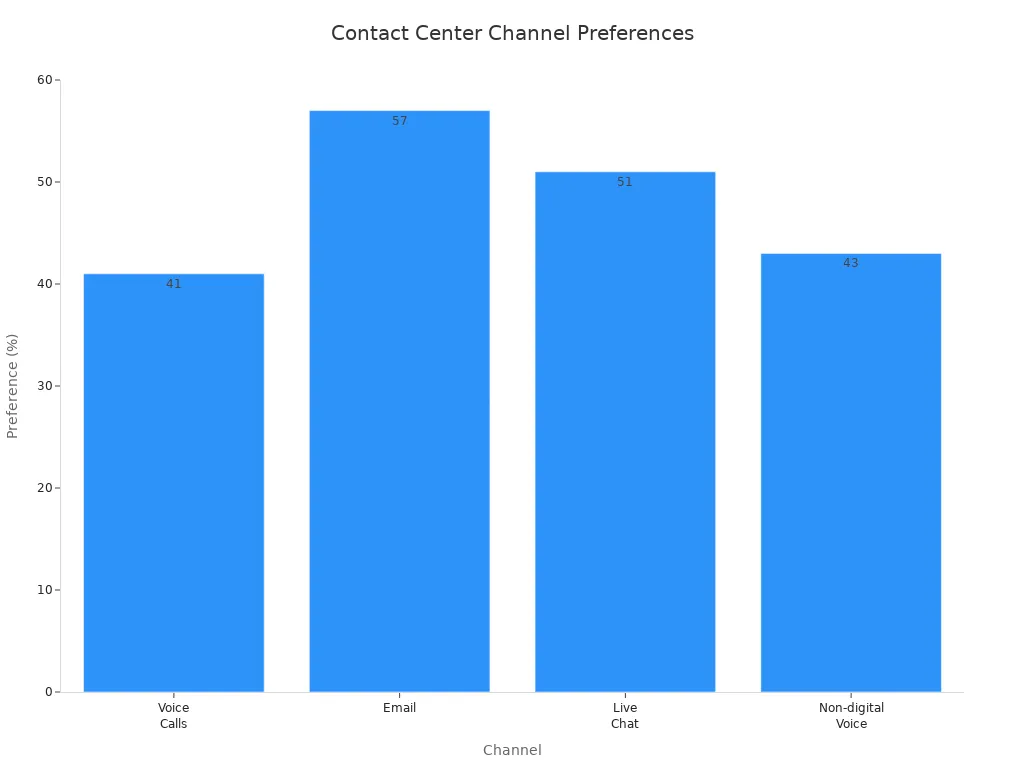
Core Functions
Contact centers perform many important functions for businesses in different industries. They handle both inbound and outbound customer communications using phone, email, chat, social media, and more. Agents use integrated platforms to manage all these channels in one place. This setup helps them respond quickly and keep track of every customer interaction.
Some of the main functions of a contact center include:
- Answering customer questions and solving problems.
- Managing complaints and collecting feedback.
- Processing orders, bookings, and payments.
- Providing IT helpdesk support.
- Using AI-powered chatbots and self-service tools to handle simple requests.
- Integrating with CRM and business systems for better service.
- Ensuring data security and following regulations.
- Scaling up to meet higher customer demand.
Contact centers also use intelligent routing systems, such as IVR, to send inquiries to the right agent. Agents receive training to handle different types of interactions and follow standard procedures to ensure quality service. Self-service options, like chatbots, help customers solve issues on their own, reducing the workload for agents.
To measure how well a contact center works, companies track key performance indicators (KPIs). The table below lists some of the most important metrics:
| Metric / KPI | Description | Purpose / Impact |
|---|---|---|
| Average Handle Time (AHT) | Total time an agent spends handling a call, including talk, hold, and wrap-up time. | Helps improve customer satisfaction by reducing call duration through efficient processes. |
| First Call Resolution (FCR) | Percentage of calls resolved on the first contact. | Indicates effectiveness, reduces costs, and improves customer satisfaction. |
| Quality Scores | Overall score reflecting the quality of caller experience. | Provides unbiased performance feedback for supervisors and agents. |
| Customer Satisfaction (CSAT) | Customer feedback collected post-call to measure satisfaction. | Reflects agent effectiveness and resolution quality. |
| Net Promoter Score (NPS) | Measures likelihood of customers recommending the service or company. | Assesses customer loyalty and overall experience. |
| Average Speed of Answer (ASA) | Time taken before a call is answered by an agent. | Identifies staffing adequacy and process efficiency; higher ASA indicates inefficiency. |
| Abandoned Call Rates | Percentage of customers who hang up before speaking to an agent. | High rates signal long wait times and potential service issues. |
| Service Level | Percentage of calls answered within a target timeframe. | Measures responsiveness and operational efficiency. |
| Agent Occupancy Rate | Percentage of time agents spend on call-related activities. | Balances agent workload to maintain performance without burnout. |
| Cost per Call (CPC) | Average cost incurred per handled call. | Provides insight into operational cost-effectiveness and resource allocation. |
Sobot’s Approach
Sobot takes a unique approach to contact center solutions by combining advanced technology with a customer-centric design. The platform integrates all communication channels—such as websites, mobile apps, social media, and calls—into a single workspace. This setup allows agents to manage every customer interaction without switching between systems. Sobot also connects with internal business tools like CRM and ticketing systems, giving agents a complete view of each customer’s history and needs.
Sobot uses AI to automate routine tasks and provide fast, accurate responses. The omnichannel AI ensures that customers receive consistent service across all touchpoints. Scenario-based AI tailors solutions for industries like retail and e-commerce, covering everything from pre-sales to post-sales support. Multi-faceted AI supports not only customers but also agents and administrators by suggesting replies and offering operational insights.
Sobot’s secure AI meets global data privacy standards, making it a trusted choice for companies worldwide.
For example, Samsung adopted Sobot’s solution and saw a 30% increase in agent efficiency and a 97% customer satisfaction rate. Sobot’s clients also report faster response times and more personalized service, which leads to higher engagement and loyalty. The platform’s AI-powered chatbots, WhatsApp Business API, and unified workspace help businesses improve productivity and reduce errors. Sobot’s approach matches or exceeds industry standards for efficiency and customer satisfaction, making it a leader in the contact center field.
Contact Center vs. Call Center
Key Differences
Industry analysts point out that call centers focus on handling large volumes of inbound and outbound voice calls. These centers use traditional or VoIP phone systems and often rely on legacy technology. Contact centers, on the other hand, use an omnichannel approach. They manage customer interactions across phone, email, chat, SMS, and social media. This integration allows for a more personalized and consistent customer experience.
Contact centers also connect with CRM systems. This connection helps agents track every customer interaction and provide tailored support. Customers expect to reach businesses through their preferred channels, and contact centers meet this need better than call centers. Companies like Sobot offer platforms that unify all these channels, making it easier for agents to deliver fast and accurate service.
Contact centers reduce response times and improve customer satisfaction, which leads to better business outcomes.
Communication Channels
Modern contact centers support a wide range of communication channels. These include voice calls, email, live chat, SMS, social media messaging, and even video chat. The table below shows how each channel serves different customer needs and preferences:
| Communication Channel | Description | Usage Statistics |
|---|---|---|
| Voice Calls | Empathy and rapport, powered by VoIP and IVR | 59% of consumers prefer voice calling |
| Written record, used across generations | 92% of U.S. citizens use email | |
| Live Chat | Real-time, 24/7 support | 72% of consumers prefer live chat over voice |
| SMS/MMS | Short text and multimedia messaging | Popular with Millennials and Gen X |
| Social Media Messaging | Engagement via platforms like Facebook, Twitter, etc. | Popular among younger generations |
| Video Chat | Face-to-face interaction remotely | Increasingly adopted |
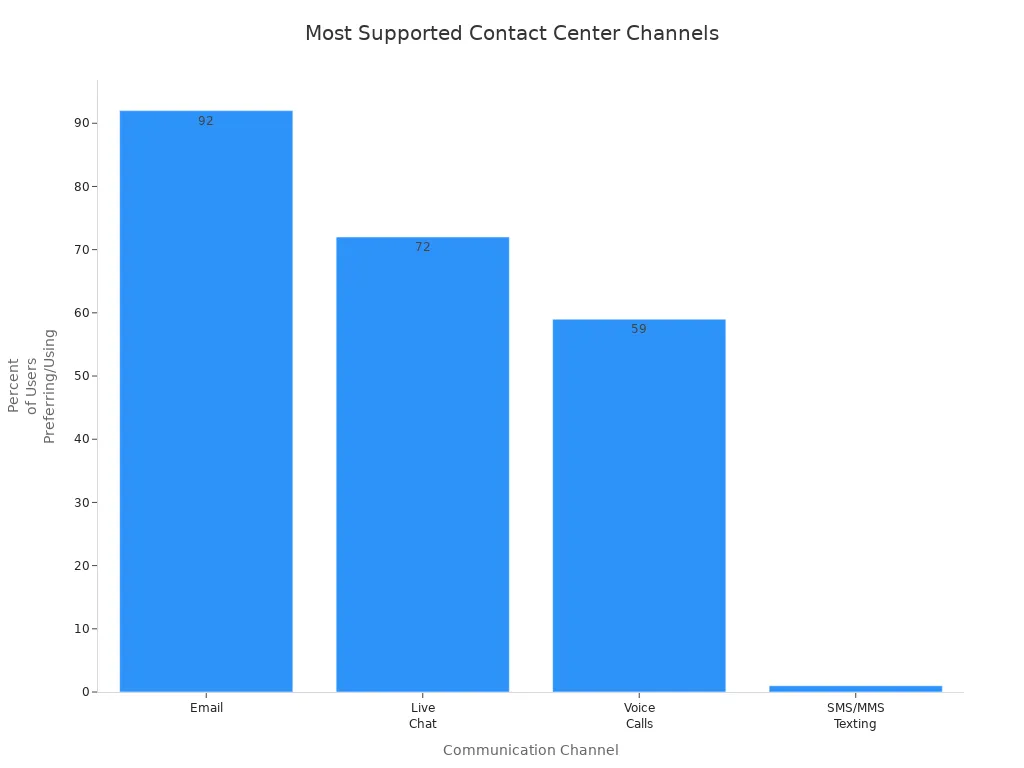
Contact centers like Sobot use omnichannel technology to integrate these channels. This integration ensures that customers receive consistent support, no matter how they choose to connect. Customers can switch between channels without losing context, which improves the overall experience.
Customer Experience
Customer experience stands at the center of the difference between contact centers and call centers. Contact centers deliver seamless, personalized interactions by using advanced tools like AI, automation, and CRM integration. Customers enjoy frictionless support and can move between channels without repeating information. This approach leads to higher satisfaction and loyalty.
In contrast, call centers offer efficient voice communication but limit customer choice and personalization. Customers may face long wait times or need to repeat details when switching channels. Research shows that companies with strong omnichannel engagement retain 89% of their customers. Sobot’s unified platform helps businesses provide this level of service, supporting agents with real-time data and AI-powered suggestions.
Multiple communication channels give customers flexibility, but only integrated contact centers can deliver a truly positive customer experience.
Types of Contact Centers

Inbound and Outbound
Contact centers come in many forms, but inbound and outbound models are the most common. Inbound contact centers focus on handling incoming requests. Customers reach out for help, order support, or information. Agents in these centers use tools like IVR and CRM systems to solve problems and answer questions. Outbound contact centers take a proactive approach. Agents call customers for sales, surveys, or reminders. These centers use auto-dialers and call scripting tools to reach many people quickly.
| Aspect | Inbound Contact Centers | Outbound Contact Centers |
|---|---|---|
| Main Focus | Customer support and issue resolution | Sales, lead generation, and marketing |
| Interaction Type | Customer-initiated | Agent-initiated |
| Key Skills | Empathy, problem-solving | Persuasion, sales |
| Technology | IVR, CRM, help desk tools | Auto-dialers, CRM, call scripting |
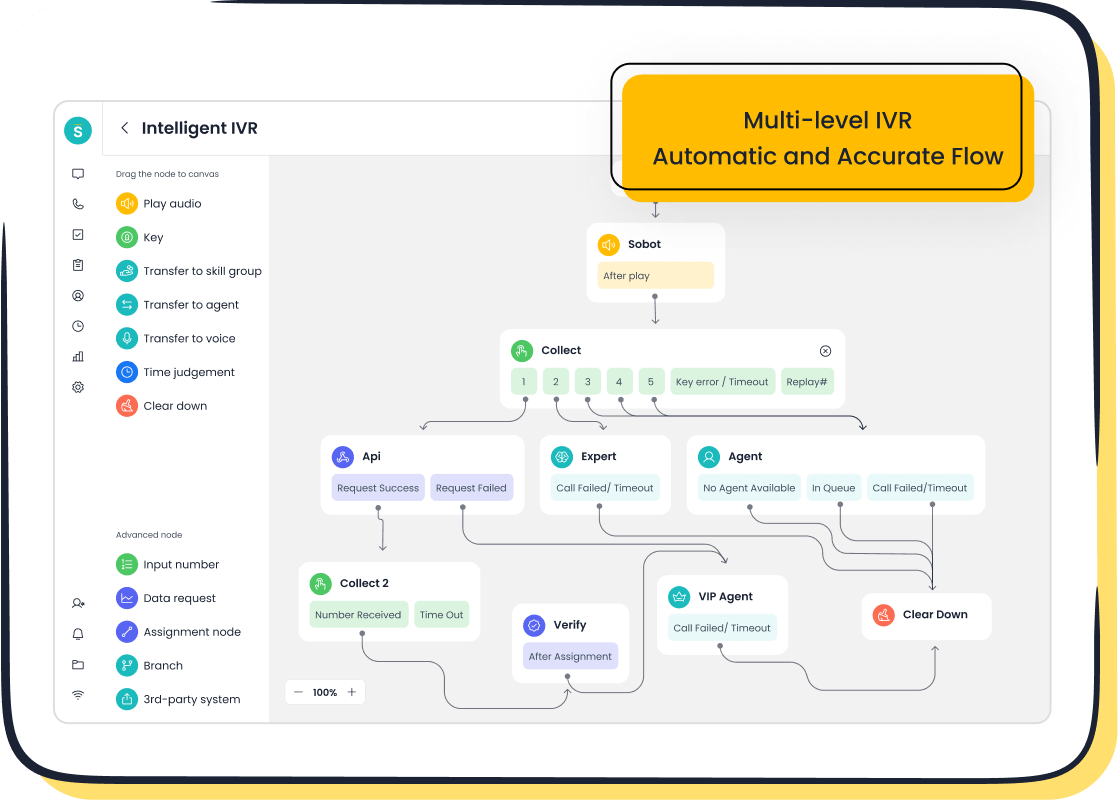
Blended or hybrid contact centers combine both approaches. Large companies often use this model to manage sales and support together. Sobot’s Voice/Call Center supports both inbound and outbound operations, making it easy for businesses to adapt as their needs change.
Multichannel and Omnichannel
Multichannel contact centers allow customers to connect through several customer support channels, such as phone, email, and social media. Each channel works separately, so agents may not see the full customer journey. This setup is cost-effective and simple for small businesses.
Omnichannel contact centers take integration further. They unify all channels into one platform, giving agents a complete view of every interaction. This approach creates seamless, personalized experiences. Research shows that 86% of customers would switch brands for better service, highlighting the value of omnichannel experiences (source). Sobot’s omnichannel solution connects websites, apps, social media, and more, supporting industries like retail, banking, and healthcare. Agents access real-time data, which improves service quality and reduces onboarding time.
Omnichannel support helps businesses deliver consistent service and build loyalty across every touchpoint.
Cloud and On-Premises
Cloud-based contact centers use online software to manage communications. Companies choose this model for its low upfront costs, fast setup, and easy scaling. Businesses can add users or features without buying new hardware. Cloud solutions also support remote work and real-time updates. Sobot’s cloud contact center offers 99.99% uptime and global reach, making it ideal for growing brands.
On-premises contact centers require companies to buy and maintain their own servers and equipment. This model gives full control but comes with higher costs and longer deployment times. Scaling up means buying more hardware and hiring IT staff. Many businesses now prefer cloud contact center solutions for flexibility and cost savings.
Sobot’s contact center solutions support both cloud and on-premises models, helping companies choose the best fit for their needs.
Contact Center Technologies
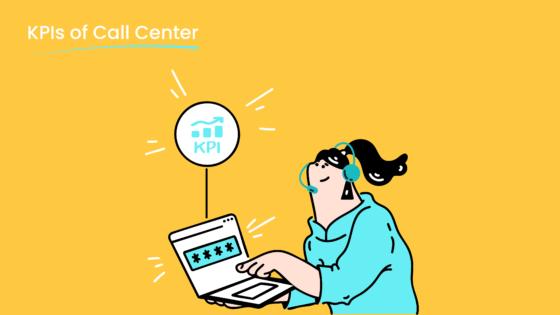
AI and Automation
AI and automation have changed how contact centers work. Modern contact center technology uses tools like Natural Language Processing (NLP) to understand what customers say and mean. AI-powered chatbots and voicebots answer simple questions any time of day, so agents can focus on harder problems. Sobot’s Voice/Call Center uses AI to route calls, analyze speech, and detect customer emotions. This helps agents respond faster and more accurately. Robotic Process Automation (RPA) handles repetitive tasks, such as ticket routing and data entry, which reduces mistakes and saves time. AI also predicts what customers might need next, making service more personal. These features help contact centers improve efficiency and customer satisfaction.
Sobot’s contact center software supports 24/7 service, multilingual support, and seamless integration with other business tools, making it a strong choice for companies with global customers.
CRM Integration
CRM integration is a key part of contact center technology. When contact center software connects with CRM systems, agents see all customer details in one place. This means they can answer questions faster and give better service. Sobot’s unified workspace brings together chat, calls, and customer data, so agents do not need to switch between screens. CRM integration also automates updates and reduces manual work, which lowers the chance of errors. Real-time data access lets agents solve problems quickly and keeps customers happy. Companies can scale their contact center without losing quality or increasing costs.
Analytics and Reporting
Analytics and reporting tools help contact centers track performance and find ways to improve. Contact center software collects data on call volume, average handle time, and customer satisfaction. Real-time dashboards show trends and alert managers to problems right away. Sobot’s advanced analytics use AI to spot patterns, predict busy times, and suggest staffing changes. The table below shows the difference between reporting and analytics in a contact center:
| Aspect | Contact Center Reporting | Contact Center Analytics |
|---|---|---|
| Purpose | Tracks what happened using KPIs | Explains why trends happen and predicts outcomes |
| Data Type | Structured metrics (e.g., call volume) | Unstructured data (e.g., call transcripts, sentiment) |
| Use Cases | Monitoring activity, reviewing metrics | Predictive staffing, root cause analysis, quality checks |
| Tools | CRM reports, Excel | AI analytics, machine learning |
| Audience | Supervisors, managers | Senior management, data scientists |
Sobot’s contact center technology gives businesses the insights they need to make smart decisions and deliver better service.
Contact Center Operations
Best Practices
Successful contact center operations depend on following proven methods that boost efficiency and customer satisfaction. Companies can use these best practices to improve results:
- Hire agents who fit the company culture and provide strong onboarding to reduce turnover.
- Use forecasting and scheduling tools powered by machine learning to match staffing with demand.
- Monitor agent performance in real time to maintain service quality.
- Give agents self-scheduling options for better work-life balance.
- Focus on agent engagement through feedback, recognition, and training.
- Set up Standard Operating Procedures (SOPs) for consistent service.
- Use intelligent routing to connect customers with the right agents.
- Automate routine tasks with AI to free agents for complex issues.
- Record and review every customer interaction for insights.
- Use AI-driven quality management to improve agent skills.
- Offer flexible work models, such as remote or hybrid setups.
- Invest in integrated solutions to lower costs and streamline contact center operations.
- Define SMART goals and benchmark against industry standards.
- Ensure compliance with data regulations.
- Build a positive culture that values teamwork and improvement.
- Track the right mix of metrics and KPIs tied to business goals.
Following these steps helps companies deliver better service and increase satisfaction.
Implementation Steps
Setting up effective contact center operations involves several clear steps:
- Define goals that match business needs.
- Choose the right type of contact center, such as cloud or on-premises.
- Select communication channels like voice, chat, or email.
- Assess software requirements for the contact center.
- Build an internal knowledge base for agents.
- Onboard and train staff with the needed skills.
- Identify tasks that can be automated with AI.
- Use forecasting tools to plan staffing.
- Integrate CRM and other business tools.
- Set and monitor KPIs for performance.
- Launch the contact center and monitor results.
- Review data regularly and make improvements.
Companies that follow these steps can create contact center operations that support high customer satisfaction and efficient service.
Sobot’s Value
Sobot delivers strong value in contact center operations by combining advanced technology with a focus on customer satisfaction. For example, OPPO used Sobot’s AI-driven chatbots and omnichannel platform to improve response times and personalize service. This led to a 30% increase in customer satisfaction scores and a 35% rise in Net Promoter Score. OPPO also saw a 57% increase in repurchase rates, showing how Sobot’s solutions drive both operational efficiency and loyalty.
Sobot’s platform supports multi-channel communication, real-time analytics, and AI-powered automation. These features help businesses manage contact center operations at scale, reduce costs, and improve satisfaction. By using Sobot, companies can meet customer needs quickly and build lasting relationships.
Customer Service Benefits
For Businesses
Businesses see clear advantages when they use modern contact center solutions. These platforms help companies improve customer experience, increase revenue, and lower costs. The table below shows some measurable benefits:
| Benefit Category | Measurable Benefit Description | Example / Statistic |
|---|---|---|
| Improved Customer Experience | Higher Net Promoter Scores (NPS) and increased customer satisfaction through video-enabled interactions | Barclays UK: NPS 44% higher on video channel vs telephony; Dekra Netherlands: 50% increase in satisfaction |
| Increased Revenue | Higher conversion rates, up-selling, and cross-selling enabled by video engagement | Apollo Munich (India): 20% increase in conversion rates; Diamond Credit Union: 12% increase in debt protection sales; BluCurrent Credit Union: 20% lift in cross-selling |
| Operational Efficiency & Cost Reduction | Reduced average handling time, increased first call resolution, agent productivity improvements, and travel cost savings | IndusInd Bank (India): 50% more cases resolved on first call; Barclays: 23% shorter handling time; Dekra: agent productivity from 6.5 to 11 appraisals/day; travel cost savings from remote claims handling |
Companies also benefit from 24/7 customer support, improved first-call resolution, and cost savings of about $0.70 per customer interaction (Juniper Research). Sobot’s omnichannel platform supports global brands in retail, finance, and technology, helping them deliver personalized customer service and achieve higher satisfaction.
For Customers
Customers enjoy a better service experience when businesses use advanced contact centers. These solutions blend technology and human care, making it easy for customers to get help anytime. The table below explains how contact centers enhance the customer experience:
| Strategy | Description & Impact |
|---|---|
| Blending Technology & Human | AI chatbots and self-service speed up routine inquiries; human agents handle complex issues with empathy. |
| Omnichannel Engagement | Unified experience across phone, chat, email, social media; tracks customer journey for personalized service. |
| Proactive Support | Anticipates customer needs using data analytics, reducing incoming support requests and improving satisfaction. |
| Empowering Self-Service | Provides customers tools to solve issues independently, enhancing satisfaction and freeing agents for complex cases. |
| Data-Driven Agent Insights | Real-time customer data enables agents to personalize interactions, anticipate needs, and build trust. |
Customers can contact businesses through their favorite channels, enjoy fast responses, and receive personalized customer service. Self-service options and proactive customer engagement help create a positive customer experience and boost loyalty.
Sobot’s Impact
Sobot delivers enhanced customer service to global brands by improving key customer experience metrics. The platform uses AI to reduce customer effort, lower support requests, and increase upsell opportunities. The chart below shows Sobot’s positive impact on NPS, customer effort, churn, upsell, and support requests:
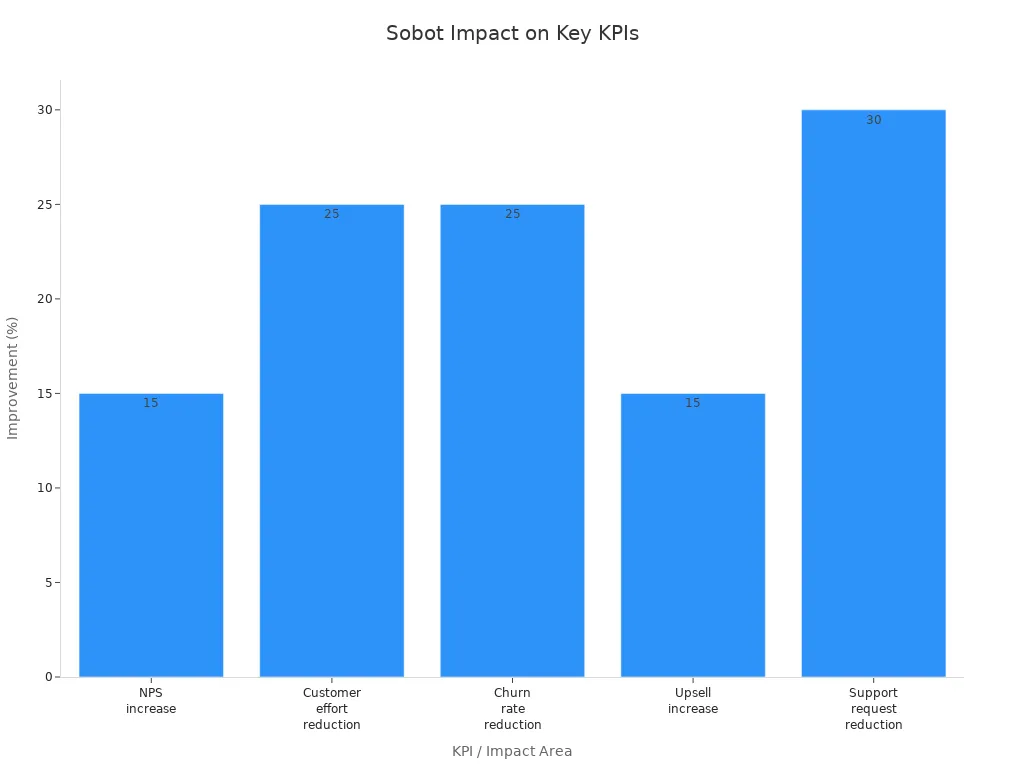
Sobot’s solutions have led to a 10-20% increase in customer satisfaction and a 25% reduction in churn rates for leading companies. By optimizing agent performance and providing personalized customer service, Sobot helps businesses achieve a seamless service experience and long-term growth.
A contact center helps companies deliver strong customer service by connecting with people through phone, chat, and more. Businesses see better results when they:
1. Set clear goals and track performance with KPIs like customer satisfaction and response time. 2. Train agents well and give them the right tools. 3. Use omnichannel solutions, such as Sobot, for seamless support. 4. Add AI and automation to speed up service and reduce agent workload. 5. Offer self-service options to help customers solve problems quickly.
Companies that follow these steps improve customer service and build lasting relationships. For more details on Sobot’s solutions, visit Sobot’s official website.
FAQ
What is the main difference between a contact center and a call center?
A contact center manages customer interactions across channels like phone, chat, email, and social media. A call center focuses only on voice calls. Contact centers offer more flexibility and better customer experience. Sobot’s platform supports all major channels for seamless service.
How does AI improve contact center performance?
AI in a contact center automates routine tasks, routes inquiries, and analyzes conversations. Sobot’s AI-powered chatbots resolve up to 83% of common questions, as seen with OPPO. This technology helps agents focus on complex issues and improves response speed.
Can a contact center help businesses save money?
Yes! A contact center reduces costs by automating tasks and improving agent productivity. Sobot’s solutions help companies lower average handling time and increase first-contact resolution. According to Juniper Research, businesses can save about $0.70 per customer interaction.
What industries benefit most from a contact center?
Many industries use a contact center, including retail, finance, gaming, and education. Sobot supports brands like Samsung, OPPO, and Luckin Coffee. These companies use contact centers to improve customer satisfaction and manage high volumes of inquiries.
How does Sobot ensure contact center reliability?
Sobot provides a contact center with 99.99% uptime and global network coverage. The system supports over 6 million online communications and 3 million phone calls daily. Sobot’s secure, scalable platform keeps customer data safe and operations running smoothly.
Tip: For more details on Sobot’s contact center solutions, visit Sobot’s official website.
See Also
Understanding The Concept Of Remote Call Centers Today
Best Cloud-Based Contact Center Services Reviewed For 2024
Leading Contact Center Technologies Evaluated For The Year 2024